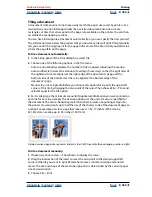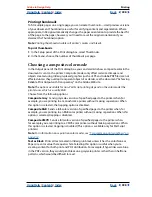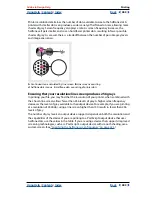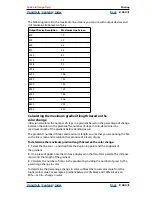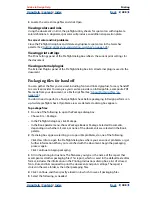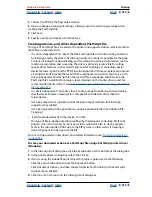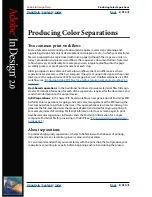
Using Help
|
Contents
|
Index
Back
402
Adobe InDesign Help
Printing
Using Help
|
Contents
|
Index
Back
402
Improving gradients and color blends in print
PostScript Level 2 and PostScript 3 output devices can print up to 256 shades of gray, and
most PostScript desktop laser printers are capable of printing approximately 32 to 64
shades, depending on the device resolution, specified screen frequency, and halftoning
method. Banding occurs when each available shade covers an area large enough for
you to see individual shades. Also, if you specify a gradient using two percentage values
that differ by less than 50%, you’re specifying a narrow range of shades that’s more likely
to result in banding. If you have difficulty printing smooth gradients without banding, try
these techniques:
•
Use a gradient that changes at least 50% between two or more process
color components.
•
Specify lighter colors, or shorten the length of dark gradients. Banding is most likely to
occur between very dark colors and white.
•
Increase the percentage of change in the gradient. (See
“Working with gradients” on
page 313
.)
•
Decrease the screen frequency for the document (PostScript output devices only). (See
“Specifying the halftone screen frequency” on page 423
.)
•
If banding occurs in an imported graphic, such as an Adobe Illustrator file, you may
need to adjust the original graphic.
•
Print to a PostScript 3 output device, which is capable of producing smoother gradients.
•
If you’re printing to a device that does not use halftone or stochastic screening (such as
dye-sublimation or continuous-tone color laser printers), select Force Continuous Tone
Behavior in the Advanced panel of the Print dialog box.
•
Use shorter gradients. The optimum length depends on the colors in the gradient, but
try to keep gradients shorter than 7.5 inches. See
“Calculating the maximum gradient
length based on the color change” on page 404
.
About halftone dots and printer dots
Most printers simulate gray by using halftone dots printed on a grid; the grid cells are
called halftone cells, and the grid rows are called lines or line screens. Each halftone dot is
made up of printer dots. As the halftone cell fills up with printer dots, the halftone dot gets
larger, resulting in a darker shade of gray.









